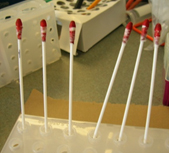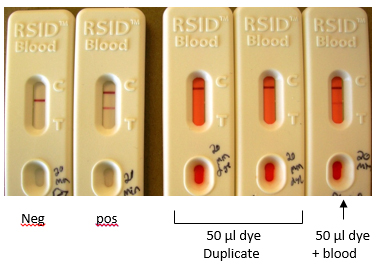
Experiment testing RSID-Blood with FD&C Red dye 40
By IFI Team | Posted on:
Background
One of IFI’s customers is a food company that uses a red dye for their candy production. During production at the candy company, there can sometimes be “red-stained areas” on the equipment and the company wanted to confirm that these areas were, in fact, the red dye and not human blood. To test for human blood, the customer was using RSID-Blood field kits. We performed experiments to confirm that the dye does not interfere with the test by creating false positives (seen if the red dye causes a red line at the test line position in the absence of blood) or false negatives (seen if the dye interferes with the signal if human blood is present causing an inaccurate negative result).
Experimental Setup
The “red 40 dye” was received in February 2013, and the experiments were performed at Independent Forensics in April 2013. 50 µL and 100 µL dye was deposited onto cotton swabs and the swabs were allowed to air-dry. To determine if the presence of the dye affected the positive signal from blood, a drop of blood from a finger prick was added to a subset of the “dye” swabs (please see figure to the left, first three swabs are 50 µL dye alone and the second set of three swabs are dye + drop of blood). As a positive control, a drop of blood was also added to blank cotton swabs. Buffer alone was used as a negative control. The swabs were tested using RSID-Blood cassettes (lot 040213G1) in the field kit format according to the protocol. Swabs were extracted for the upper and lower recommended time ranges of 20 and 50 minutes as outlined in the protocol.

Results:
There were no false positives seen from extracts made from the swabs containing 50 µL or 100 µL dye at either 20 or 50 minute extraction times (only the 20 minute extraction time is shown, see below). In addition, the dye +blood sample was clearly positive (please see cassette to the far right in figure below).

Conclusion
The results indicate that the red 40 dye does not result in a false positive when using RSID-Blood field kits. In addition, the red dye does not inhibit a positive signal seen when human blood is present. The RSID-Blood field kit is a useful tool to test for human blood if the red 40 dye is present.